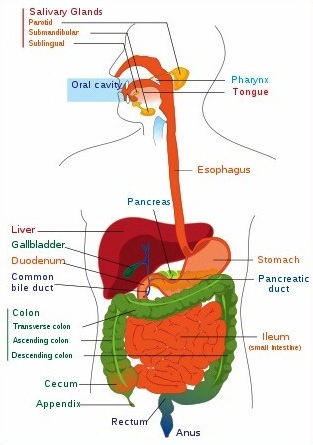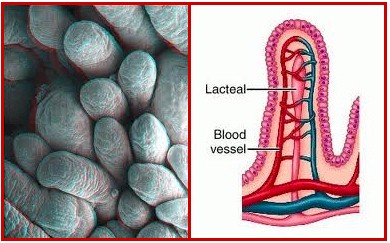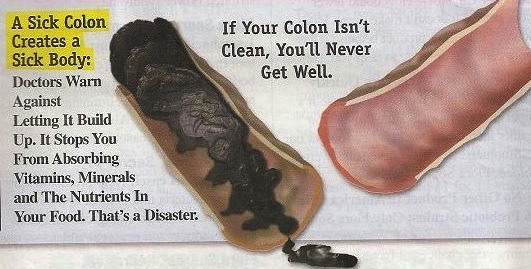An Understanding Of Your Gastrointestinal Tract And What Leads To Colon Disease
Last updated on
Gastrointestinal tract that is clogged with old fecal matters makes you sick. If your intestine isn’t clean—not only will you have a very poor immune system, a disease may develop.
Anatomy of the Gastrointestinal Tract And Its Functions
I’m surprised that when talking to many people, most don’t know what/where is the gastrointestinal tract. So, before I talk about gastrointestinal (GI) detox, let me just briefly discuss the anatomy of our gastrointestinal tract which is also our digestive system and what takes place when we eat.
In short, our digestive system begins from our mouth where food enters our body, and it runs a long way (up to 30 feet long in an adult male) while food is being processed, right down to the other end (the anus), where unusable leftover from the food is being eliminated.
Upper Gastro-intestinal Tract

When swallowed, the food enters the esophagus through peristaltic movement, to deliver the food into the stomach.
In the stomach, the stomach juices like hydrochloric acid, pepsin, gastrin and mucus, help break down the food, further resulting in a mixture called “chyme”.
During this stage, most of the bacteria that enter the body are destroyed in the stomach acid. In individuals where there is chronic indigestion due to insufficient production of stomach acid, bacteria may survive, live and begin to multiply in the intestines. Over time, this situation causes a bacterial overgrowth condition called SIBO (small intestines bacterial overgrowth).
Partially indigested foods are slowly being released into the small intestine in amounts that is right for best digestion and absorption, which is why proper digestion takes time.
Lower Gastrointestinal Tract

On the folds of the lining wall are tiny finger-like structures called villi (see picture) with fine blood vessels that absorb all the nutrients.
Vitamins, minerals, electrolytes, medications, etc. are being carried away through these blood vessels, to every part of the body. Fatty food products, however, do not enter the bloodstream through the blood vessels but are absorbed through the lacteals that connect to the lymphatic system.
More often than not, due to foods that lack fiber, most people’s small intestines have “unabsorbable” or undigested foods that get caught in between the accordion folds and among the villi. These stay in the small intestine for many years, rot and breed bacteria and parasites that cause other health issues.

The colon is the final part of our digestive system, measuring about up to 6 feet long. There are four sections to the colon: the Ascending Colon, Transverse Colon, Descending Colon and the Sigmoid Colon.
Unlike the small intestine that absorb foods and nutrients, the colon extracts water and electrolytes, and form what’s left of the wastes into feces to be eliminated. The longer it stays in the colon uneliminated, the dryer it becomes, the more difficult it would be for elimination—the cause of constipation.
And the longer it stays in the colon, the more toxic it becomes, the more bacteria and parasites are bred (by the millions everyday). And the longer the waste is in contact with the wall of the colon, not only does it get reabsorbed into the blood stream, it begins to mutilate the wall membrane that eventually leads to leaky gut, colon or rectal cancer.
Some people have so much compacted feces in the colon that the passage through which the feces are forced to travel is reduced to only a passage as thin as a pencil. If your stool is thin as a pencil or are like hard pebbles, a disease is just waiting to happen unless something is done to remove the feces build-up, and quick!
To clean out the small intestines, perform this gastrointestinal cleanse and see pounds of old fecal matters being flushed out.
To clean out the lower intestines a colon irrigation is a quick fix to clean it out, and you will need a few sessions for complete cleansing.
Another telltale sign of a toxic colon is the potbelly. It is not just fats in there, it is carrying around many pounds of old fecal matter. A person with potbelly would tend to feel tired easily, constipated, has bad breath and many other health problems. Imagine carrying a bucket of feces instead. You wouldn’t want to do that, so why carry it in your belly!!?
Some of the links I post on this site are affiliate links. If you go through them to make a purchase, I will earn a small commission (at no additional cost to you). However, note that I’m recommending these products because of their quality and that I have good experience using them, not because of the commission to be made.
Comments
Leave a Reply










































 JOIN OVER
JOIN OVER
Ms. Sarah I started back in 2011 or so reading your website page. I love the way you break down the anatomy and detox and juicing. I have quite a few health issues and I’ve neber given up on my journey to heal my body. I want to Thank you for the motivation. Have a blessed day and Happy New Year 2021